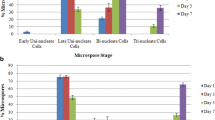Abstract
The effect of media composition on microspore culture was investigated in one tetraploid and two diploid potatoes. The viability of microspores isolated from 4.5 to 5 mm buds was in the range of 33 to 52%. In media for anther culture, microspores showed no further development and lost viability within 2 days. In M1 medium containing mineral components, sucrose, uridine, cytidine, myo-inositol, glutamine and lactalbumin hydrolysate, 18 to 37% of microspores underwent mitosis within 14 days. Up to 95% of the divisions were symmetric and produced equal nuclei. Some symmetrically divided microspores eventually produced structures with 3 to 10 nuclei. The proportion of the total microspore population producing multinuclear structures reached 9% in diploid clones responsive to anther culture and 1 to 2% in recalcitrant cv. Borka. Symmetric mitoses in M1 medium were induced in the presence of glutamine and lactalbumin hydrolysate. Nucleosides and myo-inositol had no effect on microspore division. In the absence of all organic components except sucrose, most mitoses were asymmetric, formation of multinuclear structures was reduced and most pollen accumulated starch indicative of gametophytic fate. In complete M1 medium, starch accumulation was suppressed. Suppression also occurred in asymmetrically divided microspores, indicating a direct inhibition of pollen development independent of the mode of microspore division. This inhibitory effect of M1 medium might present a stress which triggers the induction of symmetric microspore division and subsequent formation of multinuclear structures.
Similar content being viewed by others
References
Binarová P, Straatman K, Hause B, Hause G & van Lammeren AAM (1993) Nuclear DNA synthesis during the induction of embryogenesis in cultured microspores and pollen of Brassica napus L. Theor. Appl. Genet. 87: 9–16
Bugárová Z & Pret'ová A (1996) Isolated microspore cultures in Solanum tuberosum cultivars. Biologia 51: 411–416
Duijs JG, Voorrips RE, Visser DL & Custers JBM (1992) Microspore culture is successful in most crop types of Brassica oleracea L. Euphytica 60: 45–55
Eady C, Lindsey K & Twell D (1995) The significance of microspore division and division symmetry for vegetative cellspecific transcription and generative cell differentiation. Plant Cell 7: 65–74
Fan Z, Armstrong KC & Keller WA (1988) Development of microspores in vivo and in vitro in Brassica napus L. Protoplasma 147: 191–199
Jähne A & Lörz H (1995) Cereal microspore culture. Plant Sci. 109: 1–12
Johansson L (1986) Improved methods for induction of embryogenesis in anther cultures of Solanum tuberosum. Potato Res. 29: 179–190
Hause B, Hause G, Pechan P & van Lammeren AAM (1993) Cytoskeletal changes and induction of embryogenesis in microspore and pollen cultures of Brassica napus L. Cell Biol. Internat. 17: 153–168
Heslop-Harrison J, Heslop-Harrison Y & Shivanna KR (1984) The evaluation of pollen quality and of further appraisal of the fluorochromatic (FRC) test procedure. Theor. Appl. Genet. 67: 367–375
Mix G (1983) Production of dihaploid plantlets from anthers of autotetraploid genotypes of Solanum tuberosum L. Potato Res. 26: 63–67
Murashige T & Skoog F (1962) A revised medium for rapid growth and bioassays with tobacco tissue cultures. Physiol. Plant. 15: 473–497
Říhová L, HrabLetová E & Tupý J (1996) Optimization of conditions for in vitro pollen germination and tube growth in potatoes. Int. J. Plant Sci. 157: 561–566
Říhová L & Tupý J (1996) Influence of 2,4-D and lactose on pollen embryogenesis in anther culture of potato. Plant Cell Tiss. Org. Cult. 45: 269–272
Rokka VM, Pietilä L & Pehu E (1996) Enhanced production of dihaploid lines via anther culture of tetraploid potato (Solanum tuberosum L. ssp. tuberosum) clones. Amer. Potato J. 73: 1–12
Sopory SK (1977) Development of embryoids in isolated pollen culture of dihaploid Solanum tuberosum. Z. Pflanzenphysiol. 84: 453–457
Tanner GJ, Piccirilli M, Moore AE, Larkin PJ & Arcioni S (1990) Initiation of non-physiological division and manipulation of developmental pathway in cultured microspores of Medicago sp. Protoplasma 158: 165–175
Tiainen T (1992) The influence of culture conditions on anther culture response of commercial varieties of Solanum tuberosum L. Plant Cell Tiss. Org. Cult. 30: 211–219
Touraev A, Lezin F, Heberle-Bors E & Vicente O (1995) Maintenance of gametophytic development after symmetrical division in tobacco microspore culture. Sex. Plant Reprod. 8: 70–76
Touraev A, Pfosser M, Vicente O & Heberle-Bors E (1996) Stress as the major signal controlling the developmental fate of tobacco microspores: towards a unified model of induction of microspore/pollen embryogenesis. Planta 200: 144–152
Tupý J, Říhová L & Žárský V (1991) Production of fertile tobacco pollen from microspores in suspension culture and its storage for in situ pollination. Sex. Plant Reprod. 4: 284–287
Twell D, Park SK & Lalanne E (1998) Asymmetric division and cell fate determination in developing pollen. Trends Plant Sci. 3: 305–310
Van den Bulk RW, de Vries-van Hulten HPJ, Custers JBM & Dons JJM (1994) Induction of embryogenesis in isolated microspores of tulip. Plant Sci. 104: 101–111
Veilleux RE, Booze-Daniels J & Pehu E (1985) Anther culture of a 2n pollen producing clone of Solanum phureja Juz. & Buk. Can. J. Genet. Cytol. 27: 559–564
Weatherhead MA & Henshaw GG (1979) Induction of embryoids in free pollen culture of potatoes. Z. Pflanzenphysiol. 94: 441–447
Zaki MAM & Dickinson HG (1991) Microspore-derived embryos in Brassica: the significance of division symmetry in pollen mitosis I to embryogenic development. Sex. Plant Reprod. 4: 48–55
Žárský V, Garrido D, Říhová L, Tupý J, Vicente O & Heberle-Bors E (1992) Derepression of the cell cycle by starvation is involved in the induction of tobacco pollen embryogenesis. Sex. Plant Reprod. 5: 189–194
Author information
Authors and Affiliations
Rights and permissions
About this article
Cite this article
íhová, L., Tupý, J. Manipulation of division symmetry and developmental fate in cultures of potato microspores. Plant Cell, Tissue and Organ Culture 59, 135–145 (1999). https://doi.org/10.1023/A:1006473102246
Issue Date:
DOI: https://doi.org/10.1023/A:1006473102246




